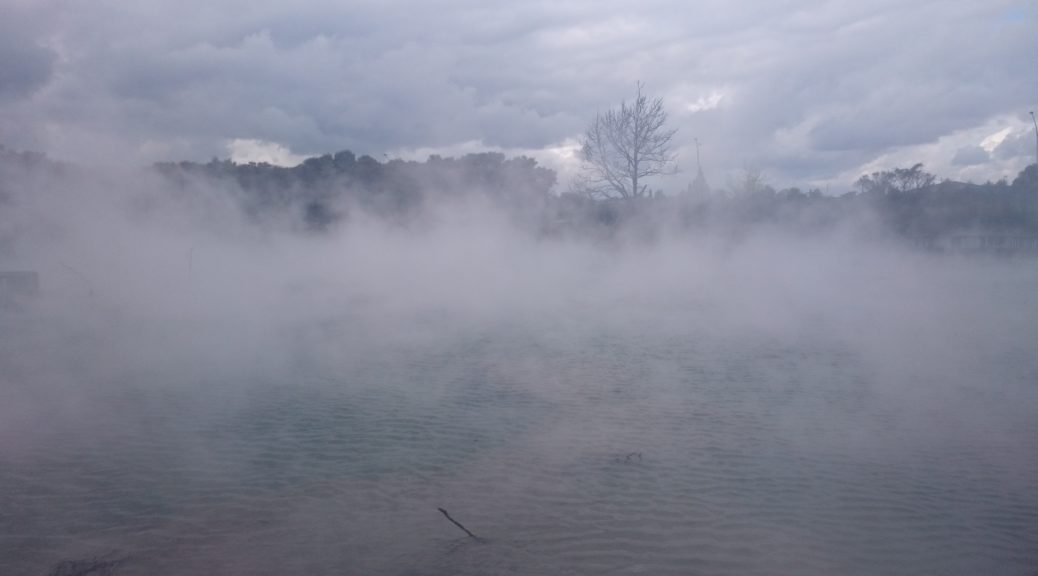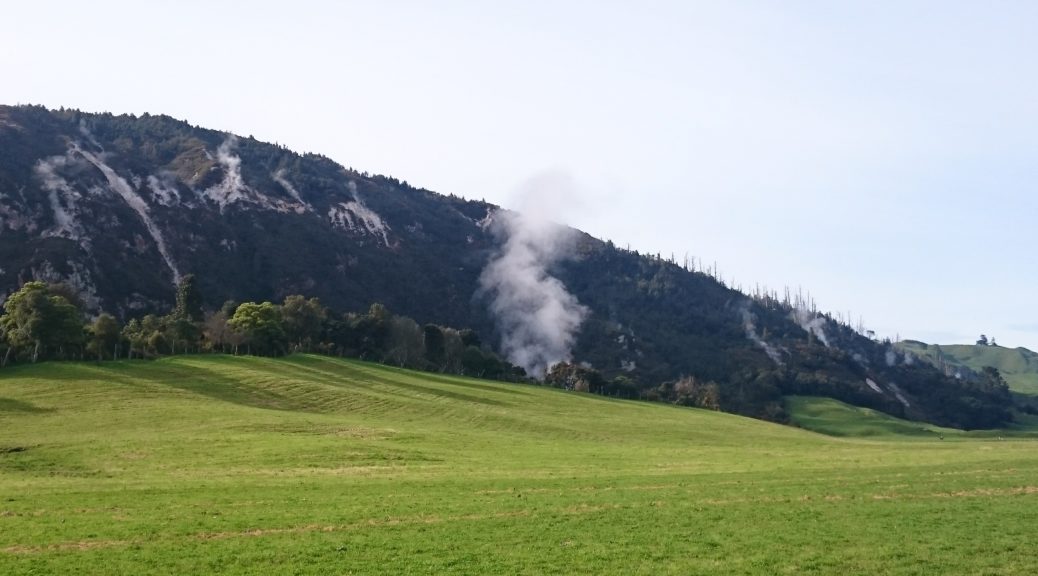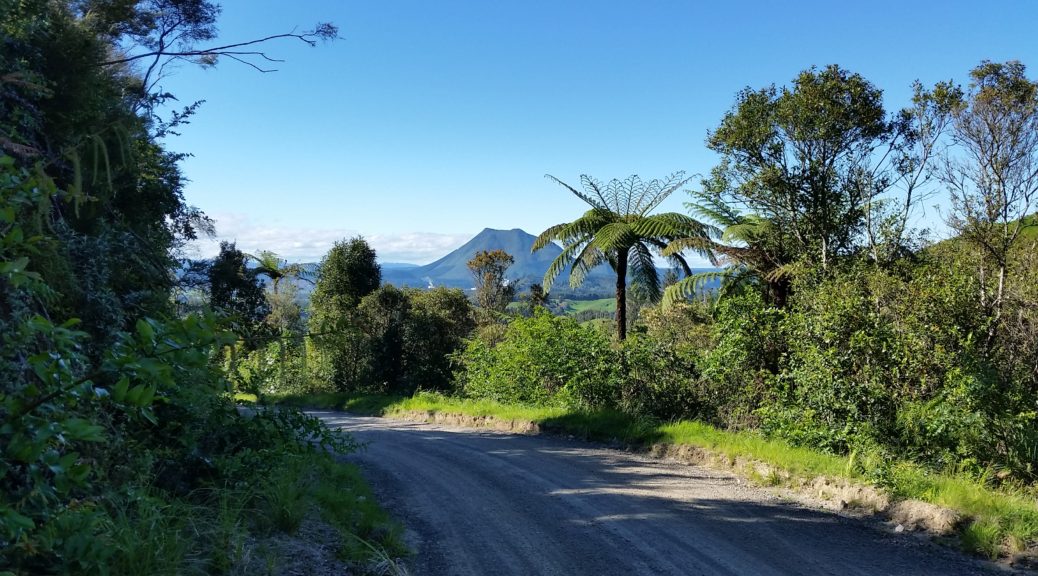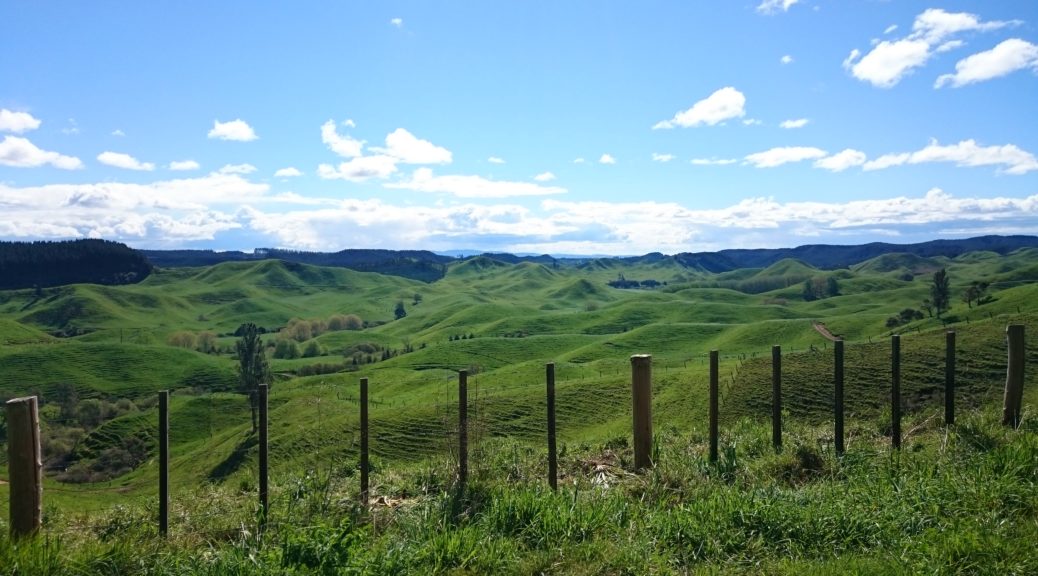In typical fashion, Steve came up with a way to cram even more into the event. Getting up before five o’clock, he was off to an early start on the final day to meet some friends as they passed through Tokoroa riding the length of the country (tag-teaming it) in a week (!) fundraising. I was having none of that and stayed out of the rain until at least it was not dark. Eventually I decided I couldn’t justify staying warm & dry any longer and got up on a proper bleak morning. Colin pulled the pin, finding it even more difficult than I was to motivate himself to ride 150 km in the rain to end up back in the same place.
With the rain strengthening and a slight wind at my back, at least the bakery was open – best pie of the four days, & “I should know, I’ve followed a few”. This was the day of the route I had been most looking forward to as the Mamaku Ranges were a place I’d driven over many times, without exploring off the highway; also, I knew little of the South Waikato – which was where most of the middle portion of the day took us. The rain was consistently soaking me as I gained about three hundred metres in the morning traffic of school buses and trucks; I was dismayed at how much litter was on the side of this particular road – by far the worst I’d seen in quite some time. Even with the steady rain, I had to stop and remove some layers from under my jacket as it was hot work climbing.
Reaching the village of Mamaku, the route turned south and followed the ridge line as it climbed up to 700 metres altitude. Soon it was a fantastic gravel road with little traffic. There was a variety of farms, native bush and plantation forest. Unfortunately the views weren’t much in the gloom. The gravel surface slowly deteriorated, without getting too bad, and the potholes were now filled with water. Unusually for a gravel road, riding in the worn tracks was noticeably slower – it was the rough bits with jagged exposed rock that were faster, easier riding; these bits were somewhat jarring and uncomfortable though.
 The rain eased the further I got from Rotorua, but it was still a rather bleak morning.
The rain eased the further I got from Rotorua, but it was still a rather bleak morning.
Turning off the ridge, it was a fast whizz down to Tokoroa, where Steve was waiting after having ridden an extra thirty kilometres at road bike pace down State Highway with the Pink Stripe (or whatever they were calling themselves). Sometimes I think I’m relatively sane.
 Main Street Tokoroa was a, ahem, cultural experience. At least the food was cheap and the portions large – which may have been deduced without walking into the bakery.
Main Street Tokoroa was a, ahem, cultural experience. At least the food was cheap and the portions large – which may have been deduced without walking into the bakery.
Erik’s (that’s him sitting with a milkshake and a coffee above) route now took us on rural backroads north to Putaruru. There was one notable pinch climb, but generally it was rather pleasant going as the rain had long left us (or vice versa). Steve was starting to feel either the effects of four days in a row in a saddle or putting his little extra excursions on top of that; we continued at an agreeable pace (well, it was agreeable to me).
 There was a strange prevalence of Series I Land Rovers around Lichfield.
There was a strange prevalence of Series I Land Rovers around Lichfield.
 Putaruru also added to our cultural learnings for the day as we stopped for a small lunch.
Putaruru also added to our cultural learnings for the day as we stopped for a small lunch.
Leaving town and dropping to our lowest point of the day, we basically only had to cross back over the Mamakus, descend to Lake Rotorua and that would be the hard work over. Off the sealed road, it was a steady climb up a long gravel road. While surrounded by trees it was easy to feel as though we were making our way on to a big plateau – but occasional glimpses showed steep valleys dropping off the side of where the road threaded its way up.
 Great gravel grinding.
Great gravel grinding.
 Steve realised we’d not got a selfie yet. I think you can see a bit of a grimace there. After five hundred kilometres and four days, the place had been found where it hurts to sit on the saddle, yet it hurts just as much to stand up on the pedals. I never doubted he’d make it, but apparently that was a little naive.
Steve realised we’d not got a selfie yet. I think you can see a bit of a grimace there. After five hundred kilometres and four days, the place had been found where it hurts to sit on the saddle, yet it hurts just as much to stand up on the pedals. I never doubted he’d make it, but apparently that was a little naive.
Just as we neared the end of Leslie Road, there was a seven hundred metre stretch mired with huge puddles and masses of mud churned up by 4WDs. I negotiated most of it until decided I could ride through the edge of this one:
 I couldn’t, much to Steve’s amusement when I ended up with rather wet & muddy feet.
I couldn’t, much to Steve’s amusement when I ended up with rather wet & muddy feet.
 Back surrounded by farmland, we got a good look at scores of these unusual formations. For some reason I thought them volcanic plugs, I’ve no idea if that’s correct.
Back surrounded by farmland, we got a good look at scores of these unusual formations. For some reason I thought them volcanic plugs, I’ve no idea if that’s correct.

Reaching the ridge again near Mamaku village, this time we turned north and rode into the wind along the ridge. Finally we had a big downhill back to lake level. We weren’t in too much of a rush to finish a great weekend’s riding, so stopped in at the bakery again for more pies.
 And then fought off the local birdlife as pies were devoured.
And then fought off the local birdlife as pies were devoured.
The last ten kilometres to the finish was flat and appropriately it followed a new cycle path through Kuirau Park, past all the steaming pools. We didn’t crash through any of the barriers, thus avoiding become another newspaper story of being scalded to terminal demise.


 The last little bit on this unusual cycle path – a little bit of frivolity snaking along the Green Corridor (although this bit is patently not green).
The last little bit on this unusual cycle path – a little bit of frivolity snaking along the Green Corridor (although this bit is patently not green).
Just like that, four great days of 550 km riding, exploring, eating & hot pooling was over. Typically there was no fanfare or anyone to mark the occasion. Except, suddenly there was. Coincidentally, Colin strolled by and then Rob (who did the two-day event) rode past on his way home from work. That was a nice little finish. A most excellent long weekend, thank for all the hard work planning & organising it, Erik.









 Admittedly, there is not much activity to be seen in this picture.
Admittedly, there is not much activity to be seen in this picture. Lake Rotorua looking a little gloomy as a strong wind whips off the lake towards our tents.
Lake Rotorua looking a little gloomy as a strong wind whips off the lake towards our tents.
 Gaining that little bit of elevation quickly confirmed that it was another glorious day in the Bay. That’s White Island puffing away on the horizon – I really should visit one day.
Gaining that little bit of elevation quickly confirmed that it was another glorious day in the Bay. That’s White Island puffing away on the horizon – I really should visit one day. While the more magnificient Tarawera Falls were near to our route, this would be the largest waterfall we saw on our trip.
While the more magnificient Tarawera Falls were near to our route, this would be the largest waterfall we saw on our trip. Looking toward Kawerau and Mt Edgecumbe partway down the descent back to the plains.
Looking toward Kawerau and Mt Edgecumbe partway down the descent back to the plains. Here’s a view of what I consider the back of Mt Tarawera, and what is definitely Steve’s back.
Here’s a view of what I consider the back of Mt Tarawera, and what is definitely Steve’s back. 
 Waiting for the off; once again Steve, as the accomplished & strong triathlete, had the pleasure of carrying our tent. I travelled lighter than in
Waiting for the off; once again Steve, as the accomplished & strong triathlete, had the pleasure of carrying our tent. I travelled lighter than in  For an event called the Geyserland Gravel Grind, appropriately our first bit of off-road trail was through thermal flats beside the lake. One of my favourite smells, the rotten-eggs of hydrogen sulphide, hung heavy in the air – we must be in Rotovegas!
For an event called the Geyserland Gravel Grind, appropriately our first bit of off-road trail was through thermal flats beside the lake. One of my favourite smells, the rotten-eggs of hydrogen sulphide, hung heavy in the air – we must be in Rotovegas! I stopped to snap a different perspective of Mt Tarawera.
I stopped to snap a different perspective of Mt Tarawera. Said perspective, looking across Okareka.
Said perspective, looking across Okareka. A nice smooth section of trail.
A nice smooth section of trail. That done, we were on the shore of yet another lake – Rotoiti.
That done, we were on the shore of yet another lake – Rotoiti. It turns out that the turn was marked, somewhat; although the trail is not immediately apparent.
It turns out that the turn was marked, somewhat; although the trail is not immediately apparent. The buildings were about the only things watching us up here.
The buildings were about the only things watching us up here. Looking west towards childhood homes – if you squint I’m sure you can see Te Puke there somewhere.
Looking west towards childhood homes – if you squint I’m sure you can see Te Puke there somewhere. We fair took over three or so sites (this being about half of our tents) – the campsite was busy with the long-weekend and the popularity of the spot.
We fair took over three or so sites (this being about half of our tents) – the campsite was busy with the long-weekend and the popularity of the spot. Back on a Bay of Plenty beach with proper sand & all! There’s even Whale Island over there too.
Back on a Bay of Plenty beach with proper sand & all! There’s even Whale Island over there too. Plenty of people out enjoying the late-afternoon sun and fishing.
Plenty of people out enjoying the late-afternoon sun and fishing.